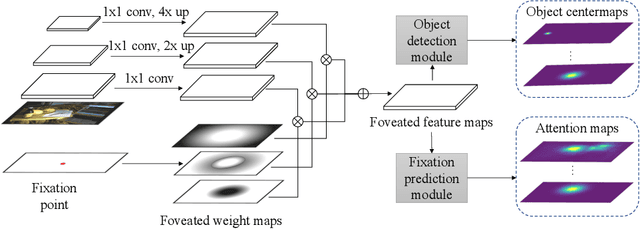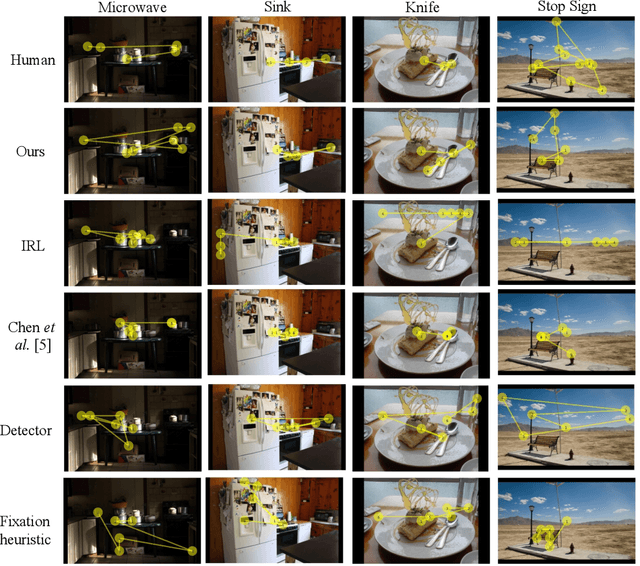Sounak Mondal
Few-shot Personalized Scanpath Prediction
Apr 07, 2025Abstract:A personalized model for scanpath prediction provides insights into the visual preferences and attention patterns of individual subjects. However, existing methods for training scanpath prediction models are data-intensive and cannot be effectively personalized to new individuals with only a few available examples. In this paper, we propose few-shot personalized scanpath prediction task (FS-PSP) and a novel method to address it, which aims to predict scanpaths for an unseen subject using minimal support data of that subject's scanpath behavior. The key to our method's adaptability is the Subject-Embedding Network (SE-Net), specifically designed to capture unique, individualized representations for each subject's scanpaths. SE-Net generates subject embeddings that effectively distinguish between subjects while minimizing variability among scanpaths from the same individual. The personalized scanpath prediction model is then conditioned on these subject embeddings to produce accurate, personalized results. Experiments on multiple eye-tracking datasets demonstrate that our method excels in FS-PSP settings and does not require any fine-tuning steps at test time. Code is available at: https://github.com/cvlab-stonybrook/few-shot-scanpath
Look Hear: Gaze Prediction for Speech-directed Human Attention
Jul 28, 2024



Abstract:For computer systems to effectively interact with humans using spoken language, they need to understand how the words being generated affect the users' moment-by-moment attention. Our study focuses on the incremental prediction of attention as a person is seeing an image and hearing a referring expression defining the object in the scene that should be fixated by gaze. To predict the gaze scanpaths in this incremental object referral task, we developed the Attention in Referral Transformer model or ART, which predicts the human fixations spurred by each word in a referring expression. ART uses a multimodal transformer encoder to jointly learn gaze behavior and its underlying grounding tasks, and an autoregressive transformer decoder to predict, for each word, a variable number of fixations based on fixation history. To train ART, we created RefCOCO-Gaze, a large-scale dataset of 19,738 human gaze scanpaths, corresponding to 2,094 unique image-expression pairs, from 220 participants performing our referral task. In our quantitative and qualitative analyses, ART not only outperforms existing methods in scanpath prediction, but also appears to capture several human attention patterns, such as waiting, scanning, and verification.
Diffusion-Refined VQA Annotations for Semi-Supervised Gaze Following
Jun 04, 2024Abstract:Training gaze following models requires a large number of images with gaze target coordinates annotated by human annotators, which is a laborious and inherently ambiguous process. We propose the first semi-supervised method for gaze following by introducing two novel priors to the task. We obtain the first prior using a large pretrained Visual Question Answering (VQA) model, where we compute Grad-CAM heatmaps by `prompting' the VQA model with a gaze following question. These heatmaps can be noisy and not suited for use in training. The need to refine these noisy annotations leads us to incorporate a second prior. We utilize a diffusion model trained on limited human annotations and modify the reverse sampling process to refine the Grad-CAM heatmaps. By tuning the diffusion process we achieve a trade-off between the human annotation prior and the VQA heatmap prior, which retains the useful VQA prior information while exhibiting similar properties to the training data distribution. Our method outperforms simple pseudo-annotation generation baselines on the GazeFollow image dataset. More importantly, our pseudo-annotation strategy, applied to a widely used supervised gaze following model (VAT), reduces the annotation need by 50%. Our method also performs the best on the VideoAttentionTarget dataset.
Predicting Human Attention using Computational Attention
Apr 04, 2023



Abstract:Most models of visual attention are aimed at predicting either top-down or bottom-up control, as studied using different visual search and free-viewing tasks. We propose Human Attention Transformer (HAT), a single model predicting both forms of attention control. HAT is the new state-of-the-art (SOTA) in predicting the scanpath of fixations made during target-present and target-absent search, and matches or exceeds SOTA in the prediction of taskless free-viewing fixation scanpaths. HAT achieves this new SOTA by using a novel transformer-based architecture and a simplified foveated retina that collectively create a spatio-temporal awareness akin to the dynamic visual working memory of humans. Unlike previous methods that rely on a coarse grid of fixation cells and experience information loss due to fixation discretization, HAT features a dense-prediction architecture and outputs a dense heatmap for each fixation, thus avoiding discretizing fixations. HAT sets a new standard in computational attention, which emphasizes both effectiveness and generality. HAT's demonstrated scope and applicability will likely inspire the development of new attention models that can better predict human behavior in various attention-demanding scenarios.
Gazeformer: Scalable, Effective and Fast Prediction of Goal-Directed Human Attention
Mar 27, 2023



Abstract:Predicting human gaze is important in Human-Computer Interaction (HCI). However, to practically serve HCI applications, gaze prediction models must be scalable, fast, and accurate in their spatial and temporal gaze predictions. Recent scanpath prediction models focus on goal-directed attention (search). Such models are limited in their application due to a common approach relying on trained target detectors for all possible objects, and the availability of human gaze data for their training (both not scalable). In response, we pose a new task called ZeroGaze, a new variant of zero-shot learning where gaze is predicted for never-before-searched objects, and we develop a novel model, Gazeformer, to solve the ZeroGaze problem. In contrast to existing methods using object detector modules, Gazeformer encodes the target using a natural language model, thus leveraging semantic similarities in scanpath prediction. We use a transformer-based encoder-decoder architecture because transformers are particularly useful for generating contextual representations. Gazeformer surpasses other models by a large margin on the ZeroGaze setting. It also outperforms existing target-detection models on standard gaze prediction for both target-present and target-absent search tasks. In addition to its improved performance, Gazeformer is more than five times faster than the state-of-the-art target-present visual search model.
Target-absent Human Attention
Jul 04, 2022



Abstract:The prediction of human gaze behavior is important for building human-computer interactive systems that can anticipate a user's attention. Computer vision models have been developed to predict the fixations made by people as they search for target objects. But what about when the image has no target? Equally important is to know how people search when they cannot find a target, and when they would stop searching. In this paper, we propose the first data-driven computational model that addresses the search-termination problem and predicts the scanpath of search fixations made by people searching for targets that do not appear in images. We model visual search as an imitation learning problem and represent the internal knowledge that the viewer acquires through fixations using a novel state representation that we call Foveated Feature Maps (FFMs). FFMs integrate a simulated foveated retina into a pretrained ConvNet that produces an in-network feature pyramid, all with minimal computational overhead. Our method integrates FFMs as the state representation in inverse reinforcement learning. Experimentally, we improve the state of the art in predicting human target-absent search behavior on the COCO-Search18 dataset
 Add to Chrome
Add to Chrome Add to Firefox
Add to Firefox Add to Edge
Add to Edge